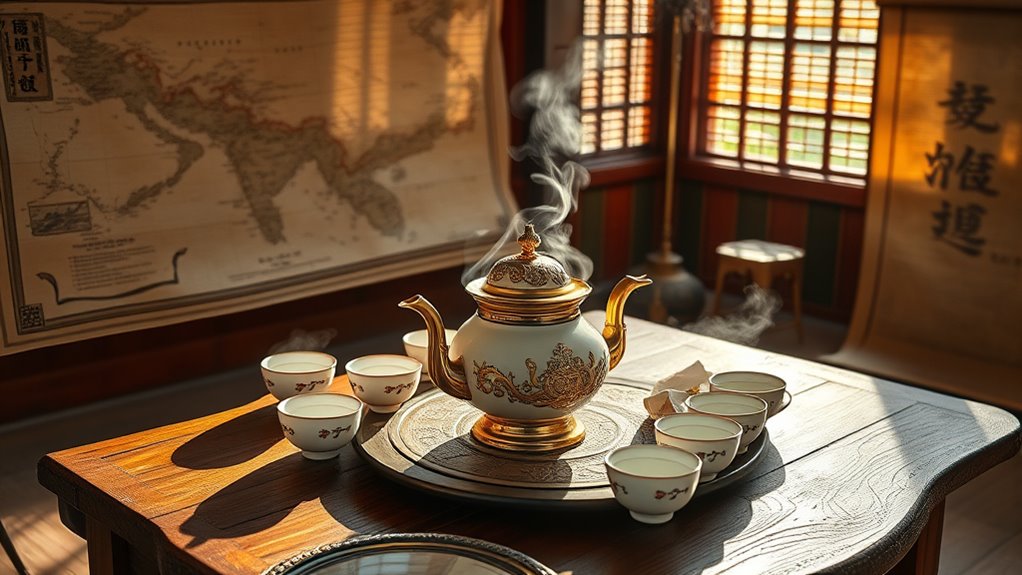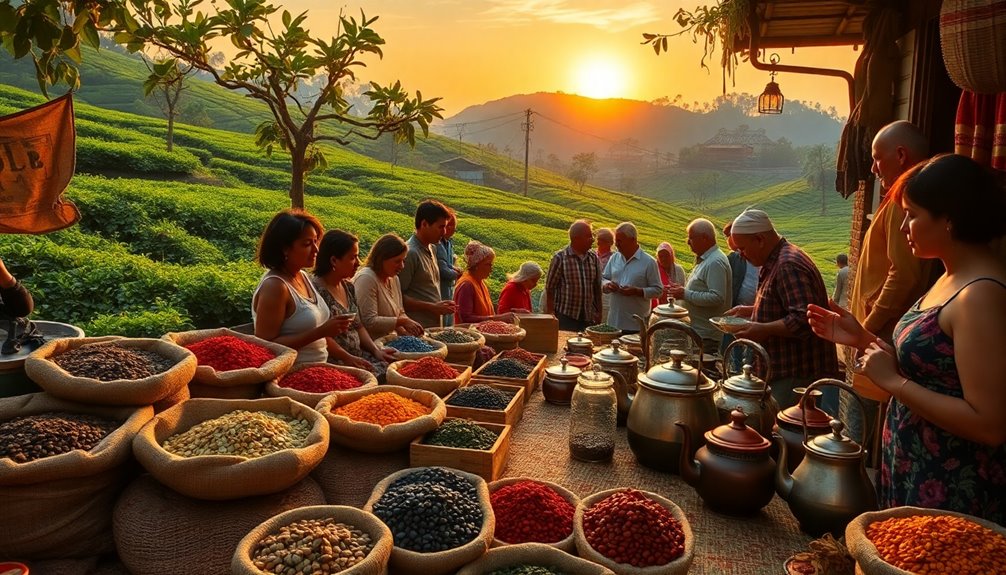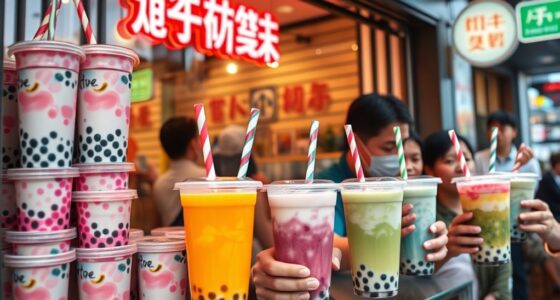Chinese tea sparked the birth of global trade routes by creating high demand that shifted commerce from overland to maritime routes. This change led to the development of sea lanes across the South China Sea and Indian Ocean, making transportation more efficient. As tea traveled across continents, it encouraged exploration, advanced navigation, and expanded cultural exchanges. If you continue exploring, you’ll discover how tea’s influence shaped the interconnected world we recognize today.
Key Takeaways
- Chinese tea’s high demand spurred the development of maritime trade routes, shifting commerce from overland to sea-based paths.
- Tea’s popularity motivated advancements in navigation, shipbuilding, and port infrastructure, enhancing long-distance maritime trade efficiency.
- The export of Chinese tea facilitated cultural exchange and trade of other luxury goods like silk, porcelain, and spices along maritime routes.
- European nations pursued direct access to Chinese tea, leading to new maritime routes, colonies, and the expansion of global trade networks.
- Chinese tea acted as a catalyst for the growth of international trade, influencing economic development and cultural interactions worldwide.

Chinese tea has played a pivotal role in shaping global trade routes for centuries. When you consider the history of tea, you’ll see how it became much more than a simple beverage; it transformed entire economies and connected distant lands. The journey begins with tea cultivation, which originated in China thousands of years ago. The Chinese perfected the art of growing and processing tea leaves, establishing a product that was highly valued both locally and abroad. As demand grew, merchants and traders sought ways to transport this prized commodity beyond China’s borders. This demand led to the development of maritime routes, where ships traversed vast oceans to carry tea to markets in Asia, the Middle East, and eventually Europe. These maritime routes became the arteries of global trade, facilitating not just the movement of tea but also the exchange of ideas, cultures, and technologies.
You’ll notice that the expansion of tea cultivation in China directly influenced the creation of these maritime routes. Initially, tea was traded overland along the Silk Road, but as demand increased, sea routes proved more efficient. The Chinese maritime route, which extended along the South China Sea and through the Indian Ocean, became a essential link connecting Chinese tea producers with traders from other parts of Asia and beyond. These maritime routes weren’t just about moving goods; they fostered a network of cultural exchanges that shaped societies along the way. As ships carried tea, they also transported porcelain, silk, spices, and other luxury goods, expanding the reach of Chinese goods and influence across continents.
Your understanding of how Chinese tea influenced the birth of global trade routes shows that the development of tea cultivation and maritime routes was mutually reinforcing. Chinese tea’s popularity created a demand that required new, more efficient transportation methods. This, in turn, prompted advancements in navigation, shipbuilding, and port infrastructure. As European nations became aware of Chinese tea, they sought direct access to Chinese markets, leading to the establishment of new maritime routes and colonies. The Age of Exploration was driven, in part, by the desire to control the lucrative trade of tea and other Chinese goods. In this way, Chinese tea didn’t just satisfy taste buds; it sparked a global movement that shaped the economic and cultural landscape of the modern world.
Frequently Asked Questions
How Did Chinese Tea Affect Local Cultures Along Trade Routes?
You see that Chinese tea shaped local cultures along trade routes by introducing new tea customs and rituals, which locals keenly adopted. These cultural exchanges fostered connections, blending traditions and strengthening relationships. As tea spread, it became more than a beverage—it became a symbol of social bonding and identity. Your understanding of these interactions highlights how Chinese tea not only influenced taste but also enriched cultural practices across different regions.
What Innovations in Transportation Were Driven by Tea Trade?
You see, the thriving tea trade drove daring developments in transportation. Maritime technology advanced as traders sought faster, safer routes across treacherous waters. Innovations like improved ships, navigational tools, and maritime maps emerged, transforming trade. These tea trade innovations not only boosted efficiency but also broadened global connections, making distant destinations reachable. Your journey through history shows how a simple sip of tea sparked a sea of maritime technological progress, shaping worldwide trade routes.
How Did Tea Influence Diplomatic Relations Between China and Other Countries?
You see, tea played a key role in shaping diplomatic relations by fostering cultural exchanges and diplomatic negotiations between China and other countries. As tea became popular abroad, it opened doors for diplomatic dialogue, showcasing Chinese culture and building trust. This shared appreciation for tea helped strengthen alliances, promote mutual understanding, and facilitate peaceful negotiations, making tea a subtle yet powerful diplomatic tool across centuries.
Were There Any Environmental Impacts From Tea Cultivation on Trade Routes?
Oh, the charming world of tea trade—where environmental degradation and resource depletion go hand in hand. You might think, “No big deal,” but cultivating vast tea plantations drained local resources, polluted soils, and disrupted ecosystems. As trade routes expanded, forests vanished, and water sources dried up. So, your cup of tea comes at a cost: a planet bearing the scars of relentless resource depletion, all to keep your sip satisfying.
How Did Tea Trade Shape Economic Policies in Different Regions?
You see, the tea trade substantially shaped economic policies in various regions through trade taxation and market regulation. Countries imposed taxes to control exports and maximize revenue, while regulating markets to ensure fair trading practices. These policies influenced trade routes, encouraging the development of infrastructure and diplomatic relations. As a result, tea trade became a catalyst for economic growth, fostering interconnected markets and laying the foundation for modern global commerce.
Conclusion
So, by sipping Chinese tea, you’re not just enjoying a simple beverage—you’re tapping into a force that reshaped the entire world map. This tiny leaf sparked a global frenzy, forging trade routes that connected continents, cultures, and economies in ways you can’t even imagine. Without Chinese tea, the modern world as you know it might never have existed. It’s truly the most astonishing, world-changing secret hidden in a humble cup!










